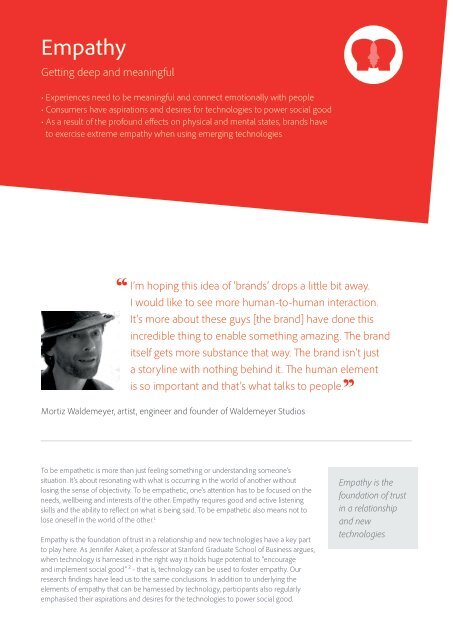FUTURE EXPERIENCE
29NdlVx
29NdlVx
You also want an ePaper? Increase the reach of your titles
YUMPU automatically turns print PDFs into web optimized ePapers that Google loves.
Empathy<br />
Getting deep and meaningful<br />
• Experiences need to be meaningful and connect emotionally with people<br />
• Consumers have aspirations and desires for technologies to power social good<br />
• As a result of the profound effects on physical and mental states, brands have<br />
to exercise extreme empathy when using emerging technologies<br />
“<br />
Without sounding too naive, my hope would be that out of the myriad<br />
possibilities enabled by VR, we see the emergence and flourishing of<br />
applications that achieve social good, and that the technology overall has<br />
a net positive effect on society. It would be great if instead of increasing<br />
people’s levels of disconnection and isolation from others (which is a<br />
risk), the technology manages to connect people and ideas in a way that<br />
is productive and makes advances towards positive aims like peace and<br />
equality. If through this technology people could more easily experience<br />
and come to understand what others are experiencing, perhaps the world<br />
could become a more tolerant and empathetic place.<br />
Sapphire, research participant<br />
“<br />
“<br />
I’m hoping this idea of ‘brands’ drops a little bit away.<br />
I would like to see more human-to-human interaction.<br />
It’s more about these guys [the brand] have done this<br />
incredible thing to enable something amazing. The brand<br />
itself gets more substance that way. The brand isn’t just<br />
a storyline with nothing behind it. The human element<br />
is so important and that’s what talks to people.<br />
Mortiz Waldemeyer, artist, engineer and founder of Waldemeyer Studios<br />
“<br />
To be empathetic,<br />
one’s attention has<br />
to be focused on the<br />
needs, wellbeing<br />
and interests<br />
of the other<br />
These emerging technologies are shifting us from staring and swiping at screens to<br />
entering new realities and having profound new experiences about what it means<br />
to be a self-reflecting, empowered human who has the ability to exercise a greater<br />
sense of personal agency on the world around them. The immersive experience<br />
that technologies like VR are able to provide through their form and function is key<br />
to focusing attention and shifting perspectives; essential elements of empathy.<br />
It’s the content that is displayed or engaged with that makes up the other half of the<br />
complex empathy algorithm - the ability to deeply connect and this should be highest<br />
on the agenda for brands. Understanding the difference between an immersive<br />
experience and an empathetic one is key if brands want to create deeply meaningful<br />
experiences. And this is what people want; 32% of GB adults we surveyed online<br />
said that a great experience for them is one that is meaningful, personal (19%) and<br />
straightforward (19%). [see figure 1]<br />
VR devices by their very nature create the immersive experience, but it’s through the<br />
content that brands will be able to create the connection. Award-winning, independent<br />
filmmaker and director Amanda Bluglass speaks about how “VR creates the locus for<br />
where a connection can be made, thereby allowing empathy to be felt.”<br />
To be empathetic is more than just feeling something or understanding someone’s<br />
situation. It’s about resonating with what is occurring in the world of another without<br />
losing the sense of objectivity. To be empathetic, one’s attention has to be focused on the<br />
needs, wellbeing and interests of the other. Empathy requires good and active listening<br />
skills and the ability to reflect on what is being said. To be empathetic also means not to<br />
lose oneself in the world of the other. 1<br />
Empathy is the foundation of trust in a relationship and new technologies have a key part<br />
to play here. As Jennifer Aaker, a professor at Stanford Graduate School of Business argues,<br />
when technology is harnessed in the right way it holds huge potential to “encourage<br />
and implement social good” 2 - that is, technology can be used to foster empathy. Our<br />
research findings have lead us to the same conclusions. In addition to underlying the<br />
elements of empathy that can be harnessed by technology, participants also regularly<br />
emphasised their aspirations and desires for the technologies to power social good.<br />
Empathy is the<br />
foundation of trust<br />
in a relationship<br />
and new<br />
technologies<br />
In recent years, some extraordinary projects have come to life as a result of VR<br />
technology; projects that are both immersive and empathetic. For example, Gender<br />
Swap, an experiment produced by BeAnotherLab in Barcelona3, uses a neuroscience<br />
technique called embodiment experience, so users are able to feel what it’s like to<br />
be in another body. To witness such a transformative experience taking place as a<br />
result of technology is unquestionably powerful.<br />
WHAT MAKES A GREAT <strong>EXPERIENCE</strong><br />
FIGURE 1<br />
32% 19% 19%<br />
meaningful personal straightforward


